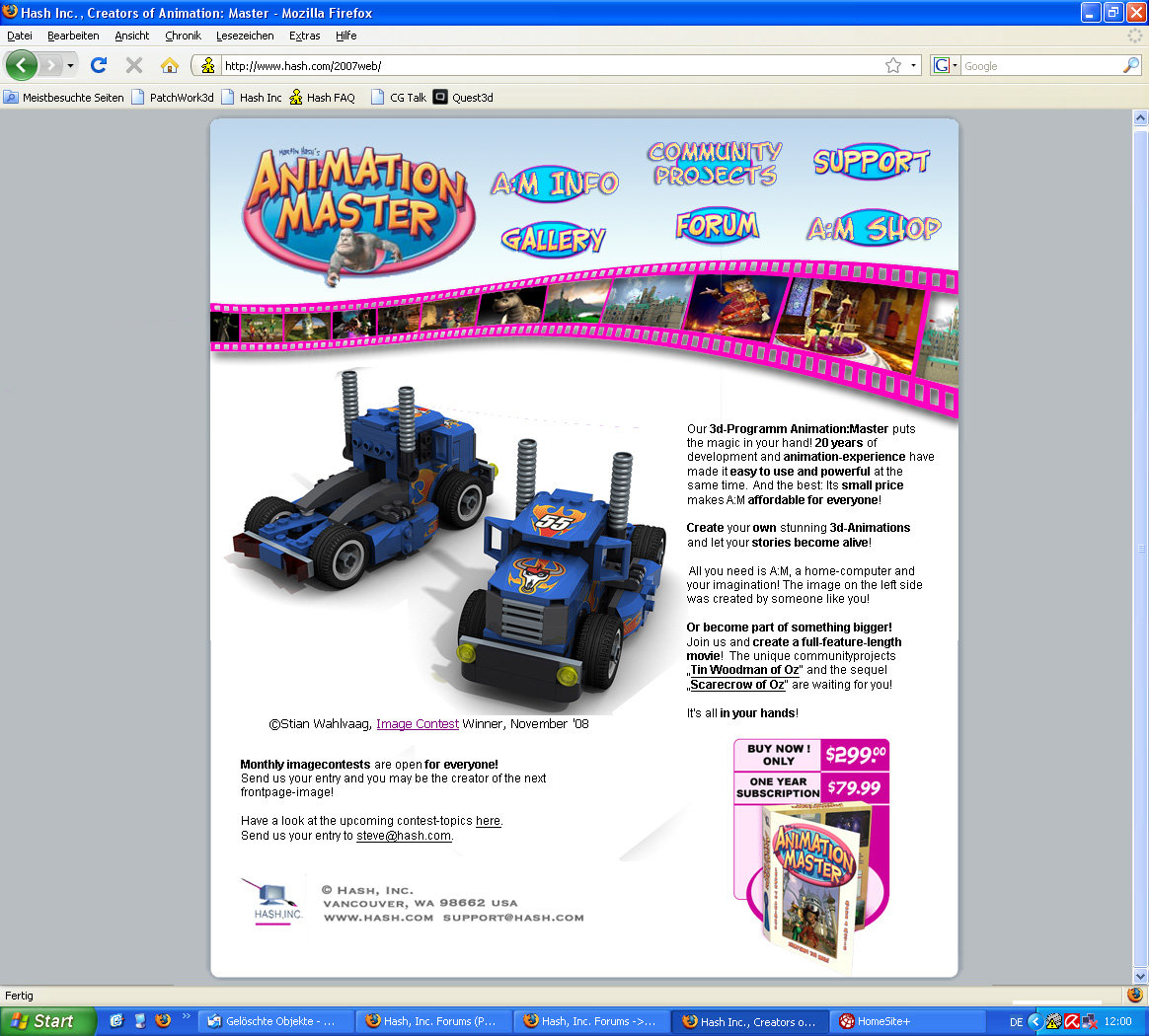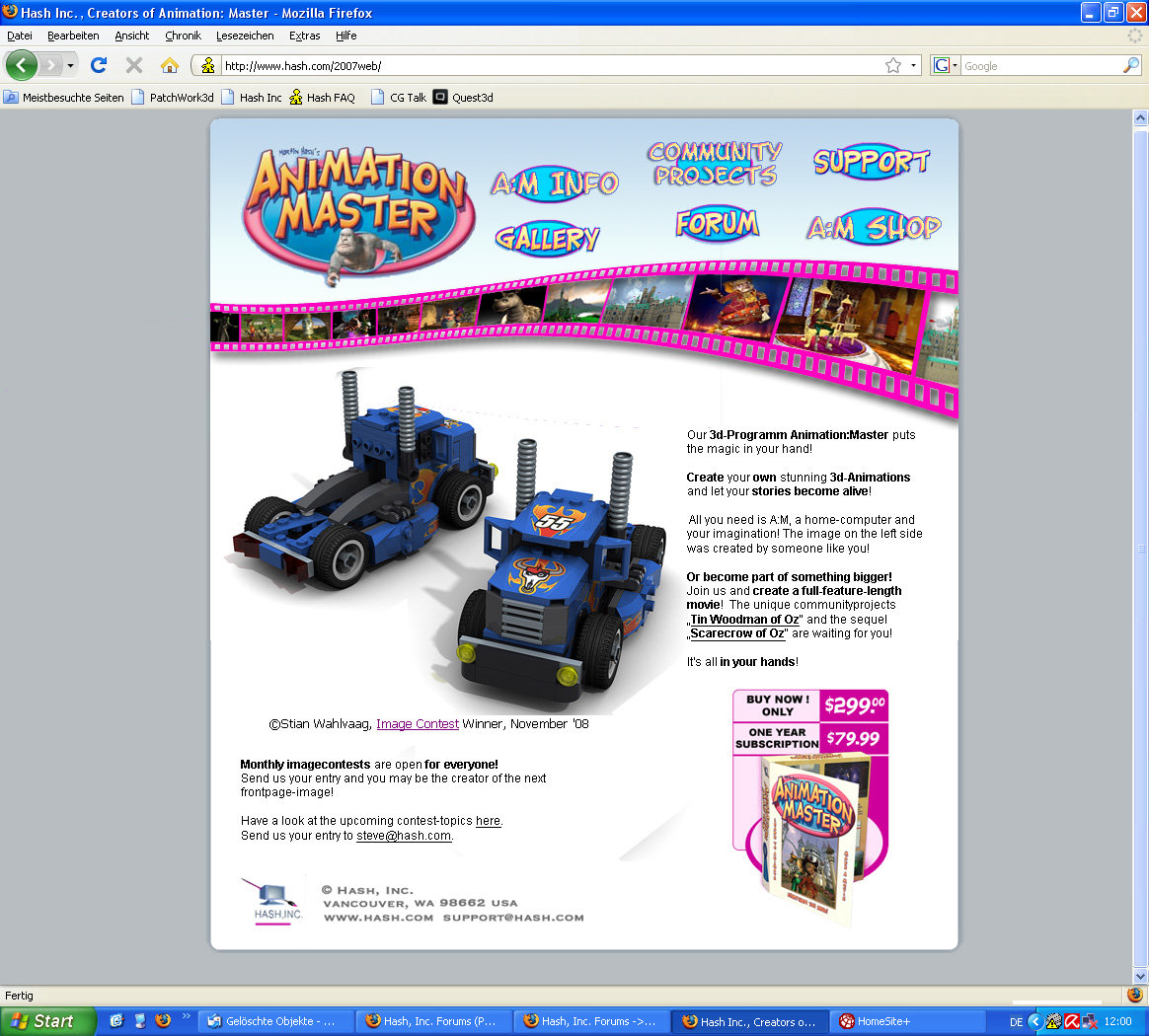-
Posts
5,412 -
Joined
-
Last visited
-
Days Won
89
Content Type
Profiles
Forums
Events
Everything posted by Fuchur
-
You know that software has to be programmed in a special way to use more than one core, right? A:M had / has the abillity to use more than one core for rendering, but it wasnt working for all people. What is working for all people is to open A:M several times and render with that. This will give you approximatly 3,5 - 3,7 times faster renderings than only with one core. You can activate more than one core-rendering with one instance too in the Registery by manually setting the thread there, but I wouldnt recommend that. It is slower and more trouble than using several instances of A:M. I recommend to use only n-1 cores so. (3 in your case) That will make the system more stable. Just open up 3-4 instances of A:M and you should get what you are asking for. *Fuchur*
-
Thanks Ken, I appreciate that... *Fuchur*
-
Hm, not that I am aware of... but you can use the mousewheel to scroll and to push down. Pushing will enable you to drag the view around while scrolling zooms in... that is nearly as good as zooming directly on the mousepointer. *Fuchur*
-
I'd love to try it Martin... Would you upload the recent Flash-files (etc.) or send it to me by email? ( info (at) patchwork3d (dot) de ) I could of course rebuilt it, but if you already got the current files, it would be easier... See you *Fuchur* PS: The free parts are meant to be there Rodney... it makes a more free-minded layout like that, so that not everything is crowded with something. I'll do some tests with your idea, but I think a horizontally text-layout has several drawbacks: First of, it wouldnt give the user all the informations on the first glance... he would have to scroll down to see the text / image (depending which one would be above the other or it would make the image quite small. I however tend to set the image at the top and make it more or less big, because it is usually worth it and a nice eyecatcher). Another problem is, that the text would be quite long horizontally. It is not too wise to create very long lines of text, especially if you are reading at a computerdisplay. It means, that the eye of the user will have trouble to have a good overview about the whole text (or even only one line) and it is quite difficult to find the next line after finishing reading the previous one. The text isnt that long neighter, so I may look a little lost if there are not enough lines... On the other hand, it would of course give the abillity to write more without breaking the layout. But too much text isn't good neighter... people's eyes dont want to read much on a computermonitor. They expect short and concise informations. Many people find it annoying to read too much text on a computermonitor. Anyhow I will try my best and if it is good enough I will try to create a second version so we can have a look on it and see which one is better suited. If you got any text-suggestions, please let me know... it's not my mothertongue, so I it is quite likeley that I write a little bit clumsily.
-
-
Hi! Till now I was only asking for something without a real recommendation of how to do it... So I thought, why not take a screenshot and try it myself? I hadnt got all the fonts, etc. used on the site, but I tried to use something in the same fashion like the once used on the current site. I think it may be more motivating for potential customers, SO-participators and people who want to create their own movies while not attracting these "featurehungry, demanding and not giving"-customers too much. It is meant for people who really want to bring their own stories to life. Hope you like it *Fuchur*
-

Licensing: What happens if i need to setup my computer anew?
Fuchur replied to Heiner's topic in Work In Progress / Sweatbox
I think it is dongled to some of the hardware in your PC / Mac / Laptop... (for example ethernetcard's mac-adress or something like that). So as long as you dont change the PC you shouldnt run into problems... and if, you just have to write Hash an email and they will give you a new activition-code and will disable the old one for you. *Fuchur* -
Totally agree with that Rodney... Changing, special or very personalized questions are best to be answered here, basic informations for the website itself. *Fuchur*
-
Rodney that sounds a bit odd... "Dont give the people basic informations... If they are not able to get them by themselves they wont do good anyway..." When I started with A:M in 2000 I started with it because of a little folder I got where A:M was promoted a little bit... (in a way I described it in my previous post). I liked the idea of being able to do characteranimations because the software I used before (discontinued since 2000) was not able to do that. But if noone would have told me about A:M and the website at that time wouldnt have been filled with informations about A:M, I wouldnt have bought it... (or better to say I wouldnt have been able to talk my dad into buying it for me for x-mas...) I am absolutly and totally believing that it is never a mistake to say a little bit about the product you are offering on a website. In which way is a matter of taste and strategey of the company, but any potential customer who want to buy a software want to get some basic infos about it. Till now people wont know what A:M is in the first place... it could be a new hoover-technolgy or a manufacture for pupals at the first glance till you click on a menuitem... And it has one big advantage: Some of these "I want to buy it but I cant find infos.."-threads will go away. People who doesnt ask if they have a problem may not be suited for A:M... but we dont have to make it more difficult for them than necessary, dont we? Anyway... its Martin's decission, not ours. I just think it is worth a thought. *Fuchur*
-
Thanks martin, thanks rodney... It's been there for two month or something like that now... @Rodney - You may want to check the what&how-section again Dont know if you already know my heighttutorial (which had a wrong linking and didnt work till now)... *Fuchur*
-
You cant import something worse than 3ds... Try to use OBJ-formats with QUADs... that may turn out well, if the model is designed well (nice edgeloops, etc.) But you got a problem there: Gamemodels are highly optimised to create a nice look from very few polygones. Normally that isnt bad, because A:M can handle smaller Patchcounts better than very high once, but it although means, that the polygones are most often not well layouted, because well layouted Polygones mean often "unnecessary" polygones which are usually very fast eliminated for better game-performances. So basicly: You can try it, but I am quite sure it wont work out well... Quad-models / formats like OBJs, which have lowpolycounts but well layouted polygones are usually coming in quite nicely... but if they are well layouted or not is often not necessary for polygon-modellers (however it is always good to layout polygones well as well ). So if the model is nice and exported as Quads, it will be okay and you will have only afew things to get it working, if not, it is more or less without hope. *Fuchur*
-
(not word for word-statement) "Hash-People are like a Patch-cult..." - said the boy from the Polygone-Cult... I made a small Softwarefocus-section on my Website about A:M.... It is not about a pure featurelists (although there are some of the more important once listed) but about the flow and feeling of A:M. I although offer Videotutorials and text tutorials (both free) on my website... It will give you some answers: Softwarefocus A:M But just to say it featurewise: A:M has everything you will need to do almost any job imagineable and it is technical on one level with other softwarepackages if not above... (depends on your view on patches/splines). Hope this helps a bit *Fuchur* PS: I hope this one is okay for you too, Martin. I think it just gives a small overview about what is possible with A:M but is not focused too much on features, etc. People have to know a bit about the software... I dont think that they will be too much of a demending crowd if they know a bit about A:M. For me A:M is the best 3d-programm because of the flow and fun A:M is offering. Any other 3d-programm laggs in this area in my opinion. But people cant know that, so maybe it would be something to add to the A:M page. Just some short infos about A:M something like: "A:M is a patchbased 3d-programm which can give you the power to create your own 3d-movies even on the kitchentable for little money." There could be some screenshots of A:Ms interface (maybe with an active TWO or SO-scene in them) and maybe a link to Gregs Demo or so...) "Create your own 3d-animations and let your stories become alive like many others did before you!" (Link to A:M Films, A:M Stills and the Milestones-Site) "Help is always available at the forum for everyone who wants to create something! (Link to the forum) "Or become part of something big! Join the Community and create a full-feature-length 3d-movie with us!" -> Links to the TWO/SO-Wiki and maybe some images of TWO and SO. "Become a part of it today: Buy Animation:Master for only 79 Dollars here." (Link to the shop) I hope this doesnt make me to one of these guys: "We don't want customers who expect us to be their personal 3D trainers, troubleshooters, coaches, salesman, or anything else where we owe them." It is just a thought and maybe you got a good reason for not doing it, but it maybe worth a thought...
-
AI 8 should be fine too... but you have to be sure that there are no groups in the AI-file. Ungroup everything, export the ai to AI8 and it should work... *Fuchur*
-
It behaves like a ballone on some of the bounces... but a ball which would go up that high at the first bounces would lose its power faster or at least would jump much farer per bounce. The weight which is implied by the first bounce is just not there in the other once... so when there is not some antigrave-machine active at the end of its bounces, something is wrong here *Fuchur*
-
I wouldnt recommend 3ds-files... it uses triangles, not quads and that is gonna kill any attempts to import them properly. OBJ-files are a little better because it uses quads, but you will have to do some rework here to. But if the model is well layouted in the polygon-programm it will be possible... (good Edgeloops, etc.) In the end: If you are able to do the model by yourself in A:M, I highly recommend to learn how to do it and do it in A:M. It is just less upsetting... See you *Fuchur*
-
Any light can have a negative value... it is a great feature to unlight certain areas (for example if you dont want the audience to see something (yet)...) It is a lesser known feature, but it is there... *Fuchur*
-
Two links to A:M-Models... Egginton - Free Collection Eggprops - Quite cheap Best thing to get if you want A:M Models: ExtraDVD And of course you should have a look at the forum here. You will get many useful infos and help to create everything you need and sometimes people post models for download here too... *Fuchur*
-
Have a look at the Buffers... you can although renderout only the shadows of a scene... the image will be a black one, but the alpha-channel will contain the informations. *Fuchur*
-

Make your 3d models a reality cheaply.
Fuchur replied to tbenefi33's topic in Work In Progress / Sweatbox
Would be a great AutoUnwrap Algorithm *Fuchur* -
You have to wait a little time till it is fully loaded... *Fuchur*
-
I dont know exactly, but if I am not wrong, normalmaped surfaces can be affected by lights in the scene (so the additional detail will be affected) while bump-maps cant do that. Displacementmaps on the other hand can manipulate the surface and will add geometry-details to the model (it wont change the mesh so, it just at it on top). A terrain-map (for example used by the Terrain-Plugin) will change the geometry. I wrote a short explaination on my website on these kind of maps when normalmaps came out... you may want to have a look at it: Difference between Bump-, Normal- and Displacementmaps I am not such an expert as Yves or so, but I think I am quite sure that it is more or less correct. *Fuchur*
-
Multipass-Renderings are generally a bit better concerning some effects and antialiasing. It depends on the scene so, if 16 passes are the same as AA... in some cases 9 passes are good enough, in others 16... In the end: I only recommend to use Multipass for still-images or if you got a real need for it... (for example: Raytraced shadows get softer by multipassrenderings, while they stay hard with AA-renderings, etc.). ZBuffer-Shadows will render in both blurred, so it is your choice. *Fuchur* PS: Top 5 Rendering-Slowdowners for me: 1.) Reflection-Level too high..,! Be sure that you have the reflectionvalue at exactly the value you need... often 2 is enough. Try it out: Render an image with 2 and after that with 5... 5 will take forever and in most cases it is just not needed. 2.) Roughness-Values are rendering less fast than bump-maps. The Antialaising of those is very timeconsuming, so I recommend to use a Bumpmap, even so they are less easy to setup. 3.) Displacementmaps are really a cool thing and they can give you much better looking objects... but be careful: They take longer to render than for example a normalmap or a bumpmap... so if you are only after small details and you dont need displacementmaps, dont use them. If you however need a very detailed object near to the camera, you should use them! 4.) Particles - While it has gotten far better in the last versions, particles are still a big timekiller in the renderingprocess. 5.) Transparent Objects, especially if you are using specularity and other surfacevalues with it... worst thing: Index of Refraction.... so if you dont really need it, dont use it. Think about rendering to different imagesquences and blending them together afterwards. It may not look exactly the same and as cool as the first attemp, but it renders far faster and it is much faster to change something afterwards. These are my top5... the first here isnt necessarily the worst thing for renderings... it highly depends on your scene.... *Fuchur*
-
You can always consolidate your project. Go to Project -> Consolidate -> Textfile and A:M will consolidate all the data of your project into a new folderstructure for you. You can now pack the folderstructure (or you can use the Consolidate + ZIP-function of A:M) and upload it here. *Fuchur*
-
Even better is the *.x-exporter... (see siganture) But yes: OBJ is better than 3ds... 3ds is a triangual format... quadformats are better suited... *Fuchur*
-
Not exactly... anyone can buy it, you dont have to own A:M to be allowed to get the websubscription. There are two "limitations". It will only run on one computer and it will run for 1 year. After that you have to buy a new subscription... But it has several advantages too... It is an easy way to get in touch with A:M (the latest available version), it is cheap and it will not ask for a CD in the drive. Everything else should be as you are used too, except the fact that you get v15 (and v16 if it comes out in the next year from your buying-time on...) *Fuchur*










